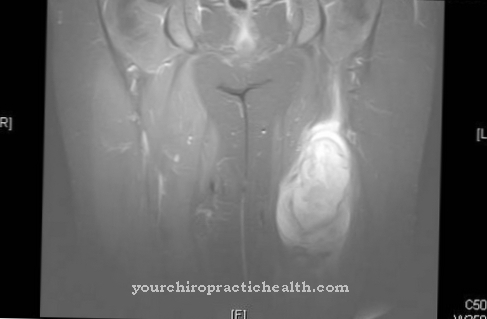Of the Biceps tendon tear, medical Biceps tendon rupture, is a possible consequence of physical overload, but also of signs of wear and tear on the biceps tendon. After appropriate therapy, coping with everyday life is usually possible again without any problems.
What is a biceps tendon tear?

© bilderzwerg - stock.adobe.com
A biceps tendon tear affects the arm flexor muscle, called the biceps brachii muscle.
A biceps tendon rupture occurs when at least one tendon in this muscle is torn. A distinction can be made between the distal biceps tendon rupture and the proximal biceps tendon rupture: While a distal biceps tendon tear occurs in the elbow area, the shoulder area is affected by a proximal biceps tendon tear.
If a biceps tendon tears, this can be expressed, among other things, by a sound that resembles a crack of a whip. In the case of a biceps tendon rupture, this sound is usually accompanied by immediate pain. In the area in which a biceps tendon ruptures, a depression can be felt after the injury, which is often provided with a hematoma (bruise).
A biceps tendon tear usually leads to functional impairments, which are expressed, among other things, in the fact that it is no longer possible to bend the elbow joint.
causes
A biceps tendon rupture can initially be caused by a sudden trauma, which can be traced back, for example, to an acute overload of the arm flexor muscle.
Such a cause for a biceps tendon rupture can be observed in strength athletes, for example, but also in craftsmen. An external force of force on the elbow, for example a blow, can also result in a biceps tendon tear. A biceps tendon tear can also be favored by performing doping; The tendon substance can be damaged by the influence of hormones, increasing the risk of suffering a biceps tendon rupture.
Signs of wear and tear on the tendon as a result of advanced age can also lead to a biceps tendon tear in active golfers, for example. Finally, various underlying diseases (such as degenerative or rheumatic diseases) can damage the tendon tissue and thus contribute to a possible biceps tendon tear.
Symptoms, ailments & signs
A biceps tendon tear is usually associated with very severe pain. This pain often spreads to the neighboring regions of the body, so that severe pain can occur in the entire arm or even in the shoulders. The quality of life of the person affected is significantly restricted and reduced.
Furthermore, muscle weakness occurs, so that it is usually no longer possible to carry out normal activities in everyday life. The biceps themselves shift due to the biceps tendon tear. There is also severe swelling and continued bruising. Since there is no self-healing, the person concerned is always dependent on medical treatment with this complaint.
Without treatment, the tendon may grow together incorrectly, which leads to further complaints and complications. In most cases, the people affected are restricted in their movement for a few months due to the biceps tendon tear. If the treatment is successful, various therapies are still necessary in order to fully restore the movement of the arm.
In most cases, the biceps tendon tear does not lead to permanent or permanent damage. In some cases, the life restrictions can also lead to psychological complaints.
Diagnosis & course
A biceps tendon tear can initially be diagnosed on the basis of the typical, visible symptoms. These symptoms of a biceps tendon tear include an impairment of the function of the elbow and / or a visible displacement of the muscle elevation away from the area of the biceps tendon tear.
More details of a biceps tendon rupture can be made visible using methods such as sonography (ultrasound) or MRI (magnetic resonance imaging). Both procedures are able to depict tissue structures affected by a biceps tendon tear.
Most of the time, a biceps tendon tear can be treated successfully, so that the subsequent everyday coping is possible without any problems. Regardless of the treatment method, elbow mobility can be limited after a cured biceps tendon tear. Surgical measures after a biceps tendon rupture can occasionally increase the risk of a new biceps tendon rupture.
Complications
As a rule, the biceps tendon tear is associated with severe pain. These can be acute and permanent or only occur when the arm is moved. As a result, the patient's everyday life is heavily stressed and restricted. However, there is also a high loss of strength in the upper arms.
Ordinary activities or sporting activities can no longer be carried out without further ado. In most cases, the muscle moves upwards, which the affected person can definitely feel. In most cases, a biceps tendon tear is treated surgically. There are no further complications here. The tendon can be attached to the bone.
Immediately after the operation, the patient's arm cannot be loaded. However, the load level is increased daily so that the arm gets used to a normal state again. The treatment is also accompanied by physiotherapy. The usual complications of an operation can arise from the surgical procedure.
These include infections and inflammations on the wound or complications in healing. Usually the patient can use the arm without restrictions after several weeks, but in this case the risk of a new biceps tendon rupture increases.
When should you go to the doctor?
If there is an urgent suspicion of a biceps tendon tear, it makes sense to see a doctor as soon as possible, as well as if there are symptoms that indicate severe overuse of the biceps tendon. There are several reasons for this.
On the one hand, it is not usually possible for those affected to distinguish whether the biceps tendon has only become inflamed due to a narrowing in the shoulder area or has already torn. For a possible operation, however, this is very important, as surgical therapy is often more successful if the biceps tendon has not yet been completely ruptured. In addition, the timely visit to the doctor is also useful in terms of the fact that a surgical intervention may even be bypassed with conservative therapy.
Another reason for visiting the doctor as early as possible is the often very unpleasant symptoms of an inflamed or (partially) torn tendon of the biceps, which can be seen mainly in severe pain and significant restrictions on movement. This can often only be improved within the framework of well-founded therapy, so that, if left untreated, overuse or irritation of the tendon due to narrowed anatomical conditions can in many cases lead to the biceps tendon tearing.
If the patient feels a crack, a prompt visit to the doctor is also important. It is not just about adequate therapy for the tendon, but also about maintaining the important function of the biceps.
Doctors & therapists in your area
Treatment & Therapy
Which medical measures are used to treat a biceps tendon rupture depends, among other things, on the symptoms of the person affected and on their physical requirements.
Basically, a biceps tendon rupture can be treated in two different ways: As part of the so-called conservative therapy of a biceps tendon rupture, surgical measures are dispensed with. The conservative therapy of a biceps tendon rupture is based, for example, on the consistent implementation of targeted physiotherapy measures.
If conservative treatment of a biceps tendon rupture does not lead to the desired success, surgical measures can be used to treat a biceps tendon rupture. If there is a biceps tendon tear in the area of the shoulder of an affected person, there is a tendency in medicine to carry out a corresponding operation using arthroscopic procedures (using instruments that are also used for joint endoscopy).
Surgical procedures can reattach the tendon to the bone if the biceps tendon ruptures; for example by sewing or hanging on the bone. If older people are affected by a biceps tendon rupture, medical professionals often tend to the gentler method of conservative therapy. However, if the lower biceps tendon is affected by a biceps tendon tear, surgery is usually performed immediately.
Outlook & forecast
A biceps tendon tear is generally associated with a good prognosis. However, the completeness and the speed of healing depend on several factors. This includes the selected form of therapy (surgical or conservative treatment), the extent of the lesion (partial or complete tear of the biceps tendon) and the patient's cooperation in regeneration.
In many cases, particular stability can be achieved through the operation. In the vast majority of cases, it restores the normal degree of mobility in the shoulder and arm area. Even patients who permanently strain the arm because of a special job or hobby often no longer complain of any functional restrictions after the operation. Sometimes there is only a slight loss of strength in contrast to the other arm. However, this is usually so low that it does not noticeably restrict the patient in everyday life and at work.
If the biceps tendon tear is caused by mechanical irritation such as constant friction against a bony structure and is associated with an inflammatory process, it is important that the cause is also treated. Only then can a flare-up of the inflammatory reaction be avoided and the operated tear on the biceps tendon can be given a good prognosis. In rather rare cases, surgical complications such as bleeding or an infection, as well as straining the arm too early, make the healing process difficult for the patient.
prevention
To prevent a biceps tendon rupture, for example, it can be helpful to warm up sufficiently before exercising. If possible, you should also avoid overstressing the arms as this increases the risk of a biceps tendon rupture. Injuries to the biceps tendon should be healed before renewed exercise in order to prevent a biceps tendon tear.
You can do that yourself
A biceps tendon tear must always be treated by a doctor. Medical treatment can then be promoted through some measures and preparations.
First of all, it is important to protect the affected body part. In the first few days, those affected are particularly advised to rest in bed and avoid strenuous or jerky movements. Thereafter, physiotherapy and alternative measures such as yoga or Pilates can support the healing process. However, depending on the severity of the tendon tear, you should wait some time before you start training again.
In particular, professional athletes and people who have to move a lot for physical or psychological reasons should therefore also consider therapeutic measures. This effectively combats depressive moods and a lack of motivation.
Various medicinal plants also contribute to healing. The pain-relieving and anti-inflammatory arnica or the antibacterial marigold ointment are effective. The use of medicinal herbs and plants should be clarified with the responsible doctor in order to avoid interactions. Lastly, the injury must be properly cared for to prevent inflammation and other complications. The same applies here: it is best to carry out all steps in consultation with the doctor.






.jpg)

















.jpg)



